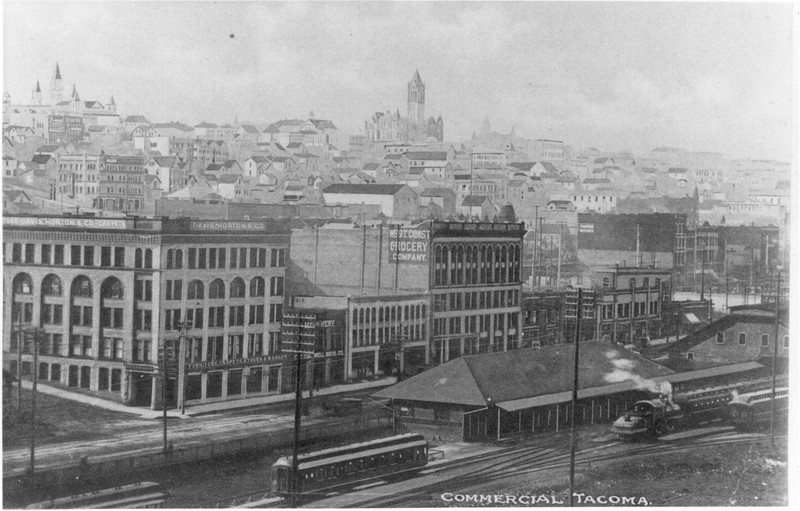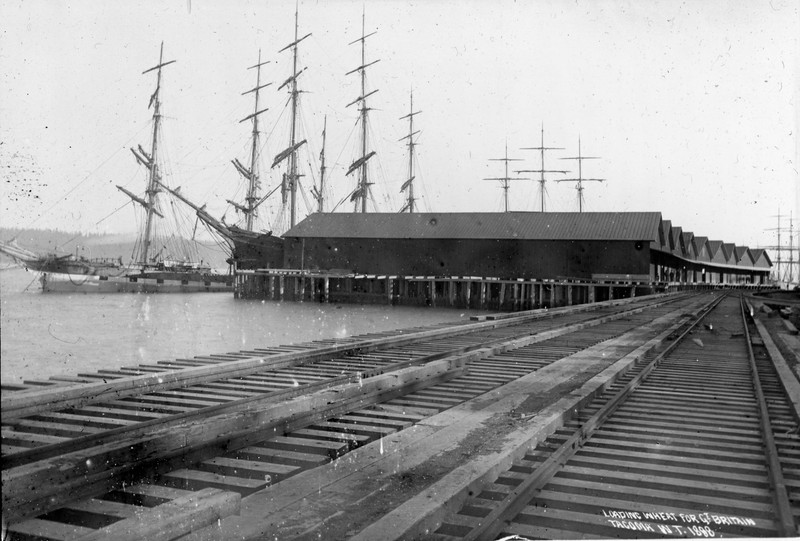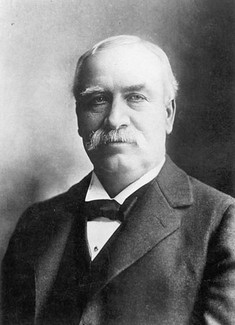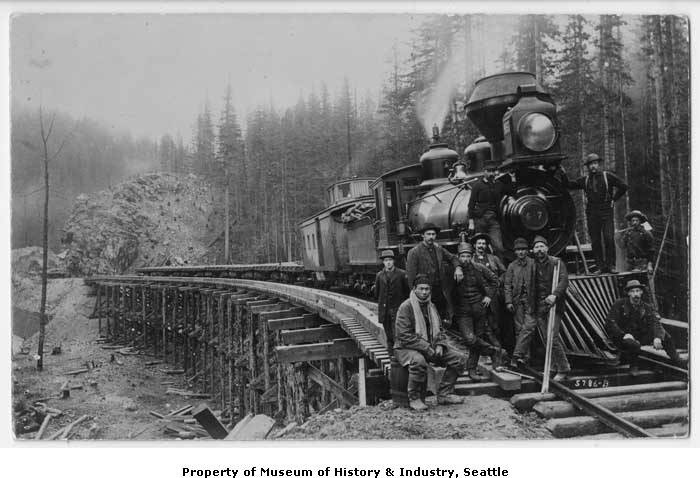Villard Passenger Depot, 1883-1892
Introduction
Text-to-speech Audio
Images
Villard Depot

Northern Pacific Railroad tracks past grain warehouses and the ships that kept them full of product.

Henry Villard (1835-1900), President of Northern Pacific Railroad 1881-1884

Group of construction workers posing in front of a Northern Pacific engine, #457, and caboose, at the Green River Crossing, 1885

Backstory and Context
Text-to-speech Audio
The railroads that powered U.S. territorial and economic expansion during and after the Civil War drew heavily on Chinese workers, especially in the western states and territories. A handful of Chinese companies facilitated workers’ travel from China to the U.S. and managed the contracts between Chinese laborers and U.S. employers in the mid-19th Century. The Northern Pacific Railway Company, which had chosen Tacoma as its western terminus, was no exception. And because Chinese residents were largely prohibited from buying real estate in Tacoma proper, most Chinese residents leased or rented from the railroad.
Prohibitions on Chinese land ownership and employment were features of 19th century western U.S. politics. By the 1880s, fears that the availability of Chinese workers would either drive down wages for white workers, be used to break worker strikes, or both, coalesced with anti-corporate activism of the period to produce strong anti-Chinese movements across California, Oregon, and the newly created Washington territory. Not hiring Chinese labor and prohibiting saloons were equally good railroad public relations campaigns by 1884. In that climate, a series of renegotiated treaties with China allowed the U.S. government to heavily restrict Chinese immigration to the U.S. for the purposes of finding work.
Tacoma was a railroad town. But it had been built on the anticipation of the completed Northern Pacific railway, not the finished product. As national economic trends and local negotiations downshifted Tacoma’s prospects, many residents became frustrated with their dependence on the railroad’s influence. In Fall of 1883, construction began on a passenger train station, on the lower side of the tracks just below Seventeenth Street. Locals called it "Villard Depot," named after the newest president of the railroad company, Henry Villard, who Tacomans considered insufficiently attentive to Tacoma's growth. The station was significantly smaller than the one they had initially planned, but the smaller station suited the passenger traffic that could be expected in the near future.
Villard employed 17,000 Chinese laborers in the completion of the Northern Pacific Line. When crews completed their work grading the wild terrain, laying railroad tracks, and constructing stations, however, railroad companies like Northern Pacific terminated those jobs. U.S. immigration policy restricted new entry for Chinese workers, but those already in the country could remain. These newly unemployed men found other forms of work on this side of the Pacific, including in Tacoma’s mills and the surrounding hop farms. They also started new businesses, first catering to the needs of their own community and then providing goods and services, most famously cheap laundries, to the general population.
In 1885, Tacoma’s Chinese community was growing. Tied to the railroads by economic circumstance as well as public opinion, that growth was met with hostility by a significant and vocal segment of Tacoma’s population. On November 3rd of that year, a large group of men acting in concert with regional anti-Chinese activists evicted between 125 and 200 Chinese from their homes and businesses across Tacoma. This was all that remained of Tacoma’s Chinese community; many others had fled, boarding trains at the Villard passenger station in the preceding weeks as calls for their departure mounted across the region. The refugees’ final moments in Tacoma were spent marching down Pacific Avenue, past the home of the city’s Mayor and finally past Villard Depot. Instead of waiting there for the next train they were turned south towards Lake View, the first station beyond Tacoma’s borders. Arriving at Lake View station that evening well after dark, they crowded into the station and several nearby sheds. Those with money purchased tickets on the next morning's passenger train to Portland, OR; those without funds boarded a 3AM freight train going in the same direction that station agents flagged to stop for them.
One week later, troops stationed in Seattle arrived in Tacoma, making camp near Villard Depot once they disembarked. They were there to guarantee the successful arrest of 27 Tacomans charged in federal court with violating U.S. law during the November 3rd expulsion of Chinese residents. Captain of Tacoma’s Home Guard Albert Whyte accompanied U.S. Marshal J.W. George to serve warrants on the men for insurrection against the U.S. government and hold them at the local courthouse until they could be put on a train to Vancouver, WA for arraignment. The next morning, a crowd of locals accompanied the Tacoma 27 to the passenger station. In Vancouver, a District Judge heard their pleas (not guilty), scheduled trial for early the following year, and set bail at $5,000 per man. Then he released them to return home. An exultant crowd met the men at Villard Depot and escorted them to a dinner and a reception celebrating their safe return. The station remained in use until it was moved across the street in 1892, then demolished nearly two decades later to make room for the much larger Union Station in 1909. Tacoma’s population had reconciled with its railroad dreams; it would take decades longer to reconcile with its anti-Chinese actions.
Sources
The Tacoma Method. Accessed September 10th 2020. https://www.tacomamethod.com/.
Murray Morgan, Puget's Sound: A Narrative of Early Tacoma and the Southern Sound (Seattle: University of Washington Press, 1979).
Herbert Hunt, Tacoma: Its History and Its Builders; A Half Century of Activity (S. J. Clarke Publishing Company, 1916).
Tacoma Public Library Historic Building Files (BU-12235)
https://en.wikipedia.org/wiki/Henry_Villard#/media/File:HenryVillard.jpg
Museum of History & Industry, Seattle; All Rights Reserved
